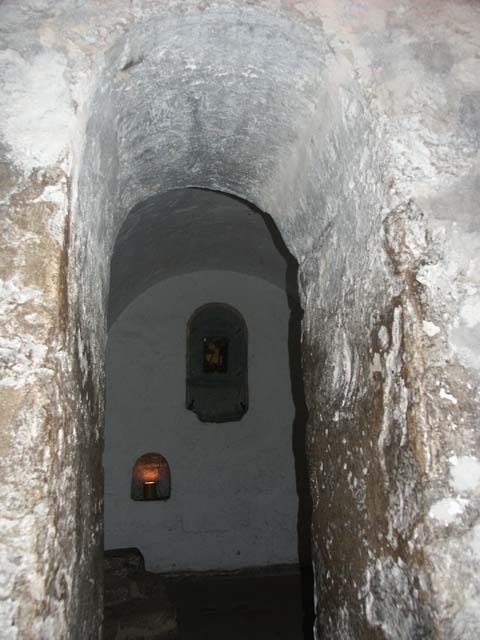

 Description;
Ripon is the modern form of the Anglo Saxon name “In
Hrypum.” The Saxon minster was built in 672AD, by St
Wilfrid. Like its “sister” foundation at
Hexham (Hagustaldesea), only the crypt remains from this time. It
has two chambers, with niches cut into the walls, and lies under the
western part of the present choir. St Wilfrid was the chief
protagonist of the the Roman tradition of the dating of easter,
decided finally at the Synod
of Whitby in 664AD. As it is known that Wilfrid was sent
here to replace a Celtic foundation who had left after refusing to
adopt the Roman tradition, there must have been a previous
establishment on this site.
Description;
Ripon is the modern form of the Anglo Saxon name “In
Hrypum.” The Saxon minster was built in 672AD, by St
Wilfrid. Like its “sister” foundation at
Hexham (Hagustaldesea), only the crypt remains from this time. It
has two chambers, with niches cut into the walls, and lies under the
western part of the present choir. St Wilfrid was the chief
protagonist of the the Roman tradition of the dating of easter,
decided finally at the Synod
of Whitby in 664AD. As it is known that Wilfrid was sent
here to replace a Celtic foundation who had left after refusing to
adopt the Roman tradition, there must have been a previous
establishment on this site.
Wilfrid was born in 634AD. At the age of 14 he entered the monastery at Lindisfarne as an attendant to a sick nobleman, then still under the rule of Aidan, who died in 651AD.
At the age of 18 he made a pilgrimage to Rome, and was inspired to bring some of the traditions in building, music and art to England. This would explain his enthusiasm for the Roman tradition at the Synod.
After a period in Gaul, during which he was consecrated as bishop, Wilfrid became bishop of York, but seems to have fallen from favour as he was imprisoned by King Ecgfrith. After being freed by Ecgfrith's successor, Aldfrith, he became embroiled in church politics, twice journeying to Rome to appeal to the Pope.
Towards the end of his life, he returned to Ripon & Hexham as bishop, and died at Oundle (In Undalum) in 709AD, his body was brought to Ripon for burial.
Ripon was also the final temporary resting place for the body of St Cuthbert. After the abandonment of the Lindisfarne monestary due to Viking raids, it's monks settled in various places as scattered as the Firths of Forth and Solway, until settling at Chester-le-Street for 100 years. However, continuing Viking pressure resulted in a further move to Ripon for a few months, until a final resting place was established at Durham, where the tomb of St Cuthbert can still be seen.
Sources; The Illustrated Bede, John Marsden; Macmillan. St Wilfrid & the Monks of Lindisfarne; Marygate House 1980.
All Photographs by the author.